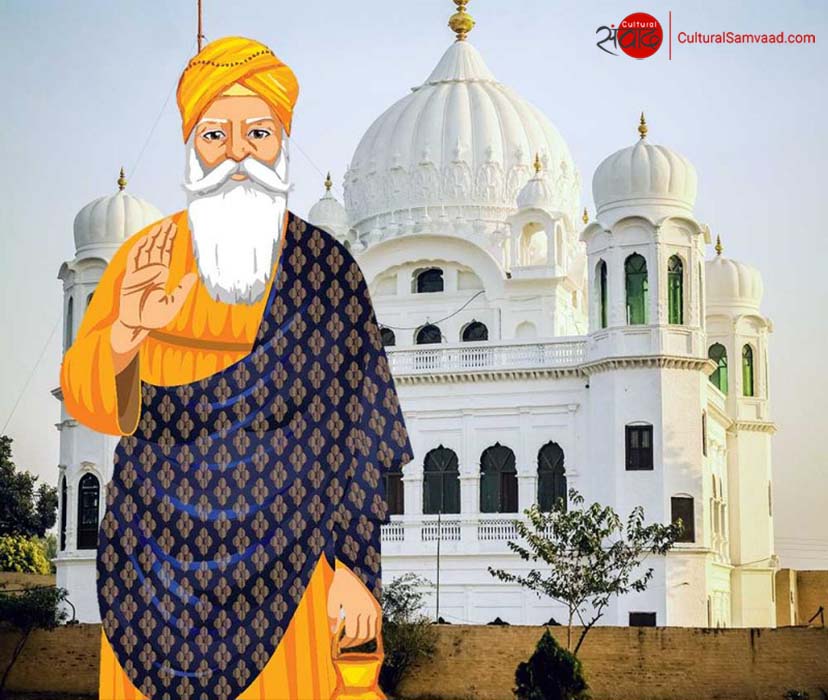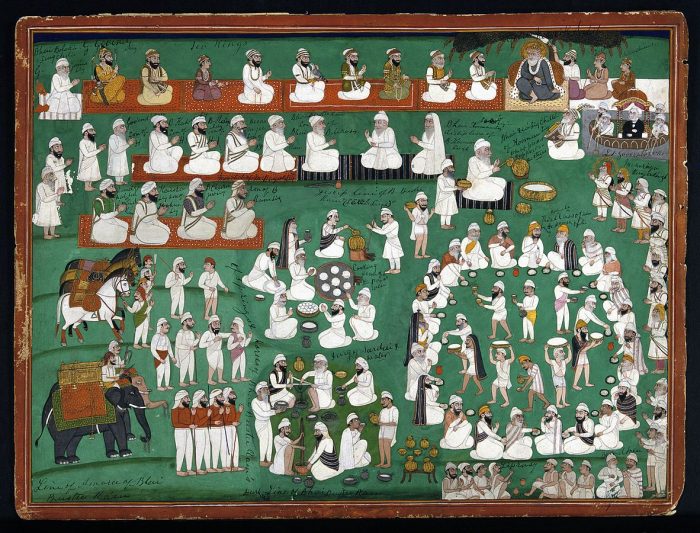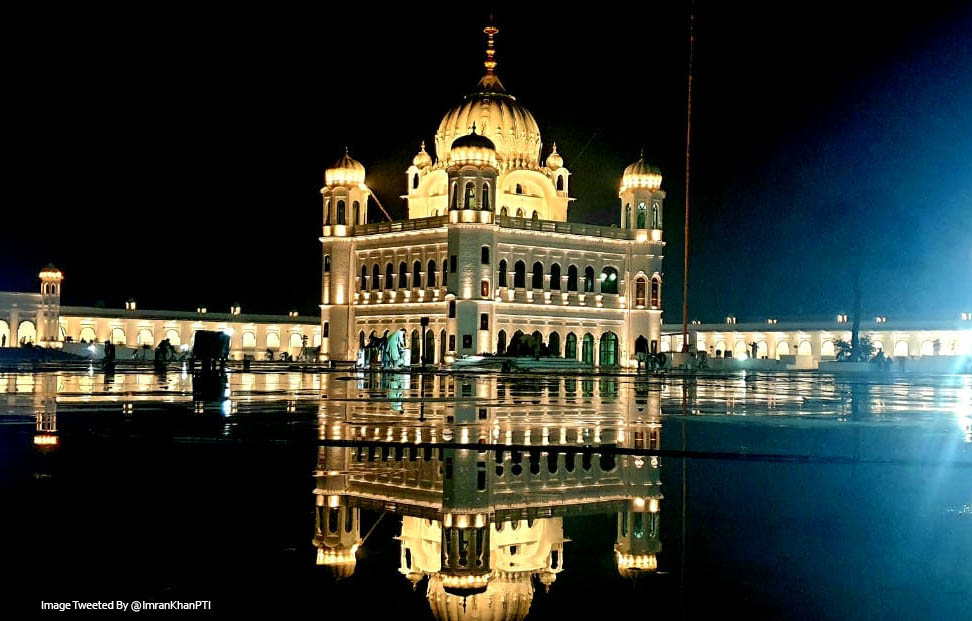 Kartarpur was founded by the first Guru in the Sikh tradition – Guru Nanak Devji. Today, it is located on the banks of the river Ravi in the Narowal district in Pakistan. For almost five centuries, the town has stood witness to the history of strife in the Indian subcontinent. Through this piece, we will try and delve into some of the stories of Kartarpur and the importance of Kartarpur.
Kartarpur was founded by the first Guru in the Sikh tradition – Guru Nanak Devji. Today, it is located on the banks of the river Ravi in the Narowal district in Pakistan. For almost five centuries, the town has stood witness to the history of strife in the Indian subcontinent. Through this piece, we will try and delve into some of the stories of Kartarpur and the importance of Kartarpur.
How and when was Kartarpur established?
The janamsakhi tradition[i] narrates the story of the establishment of the town of Kartarpur. It is said that during one of his travels (udasis), Guru Nanakji spent some period of time on the banks of the river Ravi. People from far and wide flocked at this idyllic setting to soak in his spiritual sermons and to hear him sing kirtans (prayers and hymns) in his mellifluous voice.
The land was owned by a rich Muslim landlord who is referred to as Karoria in tradition. When Karoria heard about the Guru’s fame and his teachings, he was unhappy and decided to ask him to vacate his land. It is said that when Karoria set out to meet Guru Nanak Devji, even his horse refused to cooperate with him, and he kept stumbling along the way. Karoria was advised by laymen to approach the great saint on foot with a pure heart that was free from anger and pride.
When Karoria finally met Guru Nanak Dev, he was filled with remorse and felt at peace in the Guru’s company. He is said to have begged forgiveness and dedicated the entire area to the revered Guru to lay the foundation for a new settlement.
Guru Nanak Devji proclaimed that since all land on earth belonged to the ‘karta’ or creator, the new settlement would henceforth be called ‘Kartarpur’ (the karta’s or creator’s town).
This is the beginning of the story of Kartarpur.
How did Kartarpur grow to become the focal point of the Guru’s tradition?
After the completion of his four long journeys (udasis), Guru Nanakji spent the last two decades of his life with his family at Kartarpur. He consolidated his teachings and expounded on his universal messages in Kartarpur. While the Akal Purakh (Divine) is all pervasive, it is said that one could truly feel the presence of that One Being in these serene surroundings.
The three core principles of the Guru’s teachings are ‘Naam Japna, Krit Karna and Wand Chakhna’. Babaji laid aside his pilgrim’s apparel and donned working clothes[ii] to demonstrate how these core principles could be put into practice to lead an ideal life.
While the early mornings and evenings were reserved for chanting the name (naam japna) and hymns in praise of the Akal Purakh, during the day Guru Nanakji and his disciples spent time on farming and tilling the land (krit karna).
With the help of his wife Mata Sulakhni, Babaji laid the foundations of the langar tradition by setting up the first community kitchen in Kartarpur. All human beings served in this kitchen (sewa) and partook food from the kitchen while sitting together in pangats (queues). People contributed resources to run the kitchen (wand chakhna) so that no one went hungry.

To read more about the teachings of Guru Nanak, click here.
As people started coming to Kartarpur to be in Guru Nanakji’s blessed company, sangats became a common feature of the holy city. Guru Nanakji and his followers established the first ‘dharamsaals’ (places of congregation to discuss dharma, pray and meditate) in Kartarpur. These dharamsaals later developed into gurdwaras.
The Guru also chose and groomed his successor Bhai Lehna – Guru Angad Dev in Kartarpur, before bidding farewell to this mortal world in 1539 CE. The historic Kartarpur Gurudwara is built at the site where Guru Nanak Devji left this earth (jyoti jyot).
It is said that his ashes were buried in an urn near Kartarpur and a monument was raised at that spot. One day, when the river Ravi breached its banks as a result of floods, the monument was washed away. However, Guru Nanakji’s son, Baba Sri Chand salvaged the urn containing his ashes and reburied it in another spot that was not too far away. This spot is today located in Dera Baba Nanak in Gurdaspur in India.
How was Kartarpur affected by the Tragedy of Partition? So near and yet so far…
We now jump several centuries and come to the momentous year – 1947 CE. While India attained her hard-fought freedom during 1947 CE to finally become free from the clutches of centuries of foreign rule in this year, 1947 CE was also the year when the subcontinent experienced the ravages of partition.
The infamous Radcliffe Line which tore a people and many generations apart did not spare Kartarpur. Before partition, Kartarpur was a part of the district of Gurdaspur. The June 3, 1947 announcement allotted the whole district of Gurdaspur to Pakistan. Post intervention from the Indian side, the Partition plan was revised and Gurdaspur was cruelly divided into two. Kartarpur went to Pakistan and Dera Baba Nanak remained with India.
For decades, Sikhs and Hindus lined up along the border in Gurdaspur to catch a glimpse of the Kartarpur Gurdwara in Pakistan and pay their obeisance to Guru Nanak Devji . Kartarpur seemed so near and was yet…so far… This important Gurdwara was abandoned for many decades and then later reopened in the 21st century.
Successive Indian governments and various citizen organisations had discussed and pushed for the building of a four-kms long corridor called the Kartarpur Corridor to allow pilgrims from India access to the land where Guru Nanak Dev lived and preached in the final years of his life and finally passed away. On November 9th, 2019, a few days before Guru Nanak Devji’s 550th Prakash Parv, the Kartarpur Corridor finally became reality.

While Indians hope that the Kartarpur Corridor will become a corridor of peace for this divine subcontinent, it is tough to reach this conclusion decisively in the times in which we live. I do not wish to comment on the politics of the Kartarpur Corridor but I definitely hope and pray that the spirit of Guru Nanak Devji’s eternal teachings will hold sway in this divine land. Kartarpur is and will remain the land of the creator.


Add comment